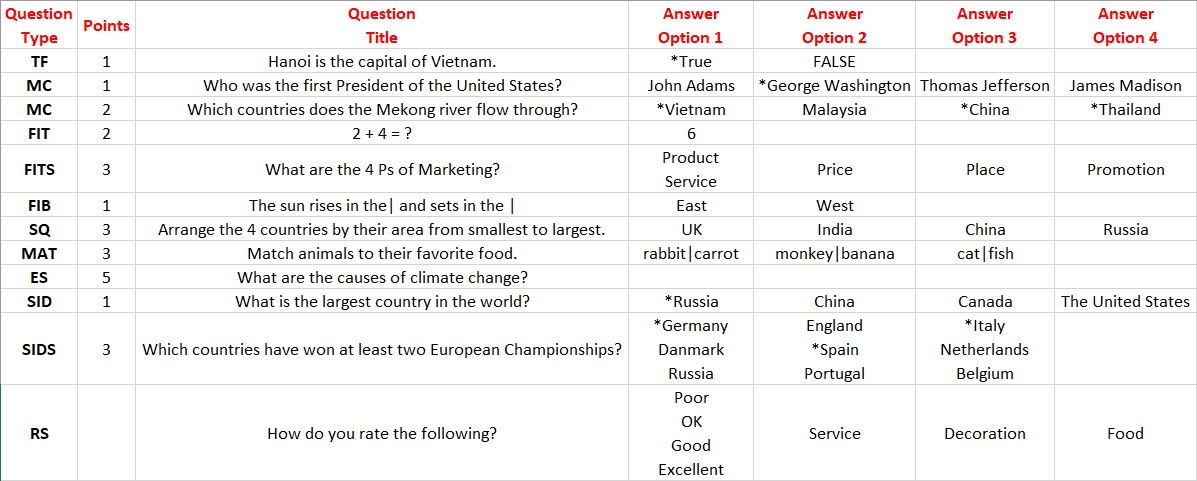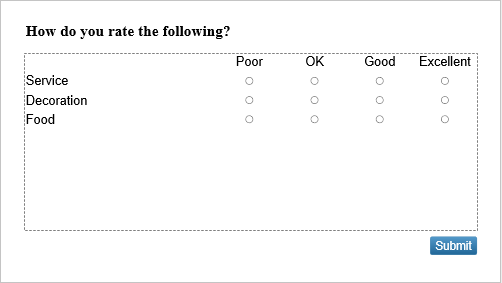Apart from adding questions in ActivePresenter manually, you can directly add questions from CSV files or GIFT files to your projects. Importing questions from these format files is useful when you need to add numerous questions to your courses at once.
In this tutorial, let’s learn how to create and add questions from CSV files to your projects in ActivePresenter 9.
What is a CSV File?
CSV stands for Comma-Separated Values. CSV files are text files that allow you to compose various question types using a plain text editor.
ActivePresenter 9 lets you import 12 question types from CSV files. They are True/False, Multiple Choice, Multiple Response, Fill in Text Entry, Fill in Text Entries, Fill in Blanks, Sequence, Drag-n-Drop, Essay, Select in Dropdown, Select in Dropdowns, and Rating Scale (Likert).
Once having your CSV files, you can directly add questions from CSV files to your project with a few clicks. If not, you have to compose questions in CSV format to create your own files and then import them to ActivePresenter. In the next part, you will learn how to make CSV files.
Create CSV Files
To create a CSV file, you open a text editor. For example, Microsoft Excel and Notepad are great text editors to write questions following CSV format.
Compose Questions Following CSV Format
CSV format has its distinct generic syntax. Therefore, it’s necessary to know the syntax to write questions in CSV format accurately.
Here is the generic syntax you need to follow when composing questions in CSV format in Microsoft Excel:
| Fields | Descriptions |
| Question Type | Use the following characters to indicate the question type you want to create: TF – True/False MC – Multiple Choice, Multiple Response FIT – Fill in Text Entry FITS – Fill in Text Entries FIB – Fill in Blanks SQ – Sequence MAT – Drag-n-Drop ES – Essay SID – Select in Dropdown SIDS – Select in Dropdowns RS – Rating Scale (Likert) |
| Points | Enter a number here to set points for a question. |
| Question Title | Input the title for a question. |
| Answer Option | Create answer options and/or define correct answers for a question. |
Note: The fields above must be created in the accurate order: Question Type > Points > Question Title > Answer Options. Otherwise, you cannot import questions from the file into ActivePresenter.
Below is a CSV file example created in Microsoft Excel:

Note: You must understand each type of question’s distinct syntax in the answer section. The next part will provide you with a detailed description of creating the answer section for each question type.
CSV Format of the 12 Types of Questions
| Question Types | Descriptions |
| True/False (TF) | Use an asterisk * at the beginning of an answer option to denote a correct answer. |
| Multiple Choice (MC) | Use an asterisk * at the beginning of an answer option to denote a correct answer. |
| Multiple Response (MC) | As this question has more than 1 correct answer, append an asterisk * to all its correct answer options. |
| Fill in Text Entry (FIT) | Input the correct answer into the first answer option column. Then, ActivePresenter will convert this answer option into a text entry. |
| Fill in Text Entries (FITS) | You can create this question type in the same way as the previous one. The only difference is that it can have one or more text entries. Besides, with each text entry, you can set more than one correct value for it. Note that each value must be on a separate line. For example, look at the Fill in Text Entries question in the image above. Its first answer option column has two values: Product and Service. They are the correct values of the first text entry. That means when learners type one of these two values, they are both accepted as the correct answer. |
| Fill in Blank (FIB) | Add one or more pipes (|) that represent blanks in the Question Title column. Fill in the answer option columns with correct values for each blank correspondingly. |
| Sequence (SQ) | Enter text or number in each answer option column. The correct answer to this question is the order of Answer Option 1 > Answer Option 2 > Answer Option 3 > … > Answer Option n. The number of answers must be greater than or equal to 2. |
| Drag-n-Drop (MAT) | Separate each answer option and its match with a pipe (|). This character denotes that this is a correct pair. |
| Essay (ES) | If you leave the answer option columns blank, essay questions are set in Survey mode. On the other hand, if you fill answer options columns with text, the questions will be set in Graded mode. The inputted text in each answer option column is considered the correct answer. |
| Select in Dropdown (SID) | Each answer option must be in a separate column. Use an asterisk (*) at the beginning of an answer option to denote a correct answer. |
| Select in Dropdowns (SIDS) | Each dropdown is in a separate column. Note that each answer option in a dropdown is on a separate line. Use an asterisk (*) at the beginning of an answer option to denote a correct answer. |
| Rating Scale (RS) | The first answer option column of this question type will function differently. In detail, all inputted values in this column are considered rating scale values. For example, Poor, OK, Good, and Excellent. Each value must be on a separate line. Meanwhile, the inputted text or number in the other columns will be recognized as answer labels. Let’s say, Service, Decoration, Food. |
This is what a Rating Scale question looks like after you add a CSV file into ActivePresenter:

Note: If you want to display a pipe | as a normal character, put it between two percent signs %%. If the pipe is put between two percent signs like this %|%, the system will display it as a vertical bar, instead of recognizing it as a pipe at the beginning of an answer option in Fill in Blanks or Drag-n-Drop questions
Once you complete the file, don’t forget to save the document as a CSV UTF-8 (Comma delimited) (*.csv) file.
Add Questions from CSV Files to ActivePresenter 9
Follow these steps to add questions from CSV files to ActivePresenter projects:
- Open the Questions tab > From File. Alternatively, in the Home tab > Interactions > From File.
- Select a CSV file (*.csv) from your computer > Open.
Then, all questions in a CSV file will be added to your project if you follow the syntax correctly. Each question will be generated on a slide separately.
You can download this CSV file sample, then follow the above steps to try importing it into ActivePresenter and see how it works.
After importing questions, you can customize properties for each of them. For example, you can change its layout, customize its feedback layers, add events – actions or randomize the order of quiz questions.
From now on, instead of creating one-by-one questions in ActivePresenter manually, you can directly import various question types from CSV files into your course within seconds.
Download ActivePresenter and give it a try now!

See Also: